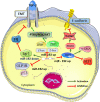Roles of microRNA-192 in diabetic nephropathy: the clinical applications and mechanisms of action
- PMID: 37396169
- PMCID: PMC10309560
- DOI: 10.3389/fendo.2023.1179161
Roles of microRNA-192 in diabetic nephropathy: the clinical applications and mechanisms of action
Abstract
Diabetic nephropathy (DN) is one of the most common and intractable microvascular complications of diabetes worldwide, serving as the main cause of terminal renal disease. Due to the lack of early specific symptoms and diagnostic markers, DN severely threatens the sufferer's life. MicroRNA-192 (miR-192) was early identified in human renal cortical tissue and stored and excreted in urine as microvesicles. MiR-192 was found to be involved in the development of DN. For the first time, the present review summarized all the current evidence on the topic of the roles of miR-192 in DN. Finally, 28 studies (ten clinical trials and eighteen experimental studies) were eligible for thorough reviewing. Most of the clinical trials (7/10, 70%) indicated miR-192 might be a protective factor for DN development and progression, while the majority of experimental studies (14/18, 78%) suggested miR-192 might be a pathogenic factor for DN. Mechanistically, miR-192 interacts with various direct targeted proteins (i.e., ZEB1, ZEB2, SIP1, GLP1R, and Egr1) and signaling cascades (i.e., SMAD/TGF-β and PTEN/PI3K/AKT), together contribute to the pathogenesis of DN through epithelial-to-mesenchymal transition (EMT), extracellular matrix deposition, and fibrosis formation. The current review highlights the dual role of miR-192 in the development of DN. Low serum miR-192 expression could be applied for the early prediction of DN (the early stage of DN), while the high miR-192 level in renal tissues and urine may imply the progression of DN (the late stage of DN). Further investigations are still warranted to illustrate this inconsistent phenomenon, which may facilitate promoting the therapeutic applications of miR-192 in predicting and treating DN.
Keywords: MicroRNA-192; Zeb1; biomarker; diabetic nephropahy; mechanism.
Copyright © 2023 Wan, Liao, Lai, Zhang, Cui and Chen.
Conflict of interest statement
The authors declare that the research was conducted in the absence of any commercial or financial relationships that could be construed as a potential conflict of interest.
Figures

Similar articles
-
MicroRNA-21: A Critical Pathogenic Factor of Diabetic Nephropathy.Front Endocrinol (Lausanne). 2022 Jul 5;13:895010. doi: 10.3389/fendo.2022.895010. eCollection 2022. Front Endocrinol (Lausanne). 2022. PMID: 35865316 Free PMC article. Review.
-
LncRNA NEAT1 promotes extracellular matrix accumulation and epithelial-to-mesenchymal transition by targeting miR-27b-3p and ZEB1 in diabetic nephropathy.J Cell Physiol. 2019 Aug;234(8):12926-12933. doi: 10.1002/jcp.27959. Epub 2018 Dec 13. J Cell Physiol. 2019. PMID: 30549040
-
Ski-related novel protein suppresses the development of diabetic nephropathy by modulating transforming growth factor-β signaling and microRNA-21 expression.J Cell Physiol. 2019 Aug;234(10):17925-17936. doi: 10.1002/jcp.28425. Epub 2019 Mar 7. J Cell Physiol. 2019. PMID: 30847937
-
Diminution of microRNA-98 alleviates renal fibrosis in diabetic nephropathy by elevating Nedd4L and inactivating TGF-β/Smad2/3 pathway.Cell Cycle. 2020 Dec;19(24):3406-3418. doi: 10.1080/15384101.2020.1838780. Epub 2020 Dec 14. Cell Cycle. 2020. Retraction in: Cell Cycle. 2022 Dec;21(24):2673. doi: 10.1080/15384101.2022.2137765. PMID: 33315506 Free PMC article. Retracted.
-
Stem cell-derived and circulating exosomal microRNAs as new potential tools for diabetic nephropathy management.Stem Cell Res Ther. 2022 Jan 24;13(1):25. doi: 10.1186/s13287-021-02696-w. Stem Cell Res Ther. 2022. PMID: 35073973 Free PMC article. Review.
Cited by
-
Study of MicroRNA-192 as an Early Biomarker for Diagnosis of Diabetic Nephropathy.Diagnostics (Basel). 2025 Jun 13;15(12):1504. doi: 10.3390/diagnostics15121504. Diagnostics (Basel). 2025. PMID: 40564825 Free PMC article.
-
The Role of miR-802 in Diabetic Kidney Disease: Diagnostic and Therapeutic Insights.Int J Mol Sci. 2025 Jun 7;26(12):5474. doi: 10.3390/ijms26125474. Int J Mol Sci. 2025. PMID: 40564936 Free PMC article. Review.
-
[The Role of TGF-β1/SMAD in Diabetic Nephropathy: Mechanisms and Research Development].Sichuan Da Xue Xue Bao Yi Xue Ban. 2023 Nov 20;54(6):1065-1073. doi: 10.12182/20231160108. Sichuan Da Xue Xue Bao Yi Xue Ban. 2023. PMID: 38162063 Free PMC article. Chinese.
-
What a Modern Physician Should Know About microRNAs in the Diagnosis and Treatment of Diabetic Kidney Disease.Int J Mol Sci. 2025 Jul 11;26(14):6662. doi: 10.3390/ijms26146662. Int J Mol Sci. 2025. PMID: 40724919 Free PMC article. Review.
-
The Pathophysiology and Vascular Complications of Diabetes in Chronic Kidney Disease: A Comprehensive Review.Cureus. 2024 Dec 28;16(12):e76498. doi: 10.7759/cureus.76498. eCollection 2024 Dec. Cureus. 2024. PMID: 39872596 Free PMC article. Review.
References
Publication types
MeSH terms
Substances
LinkOut - more resources
Full Text Sources
Medical
Research Materials

